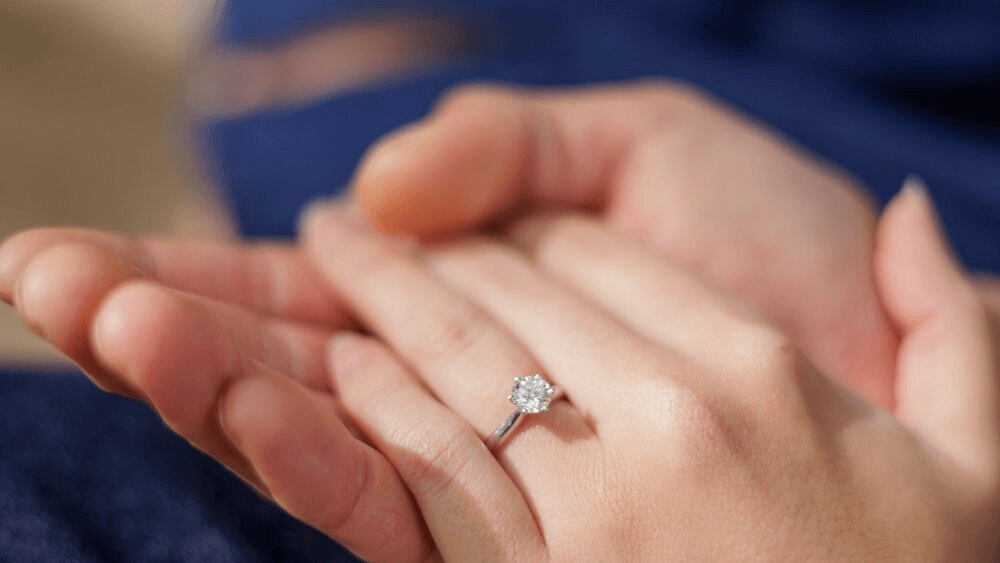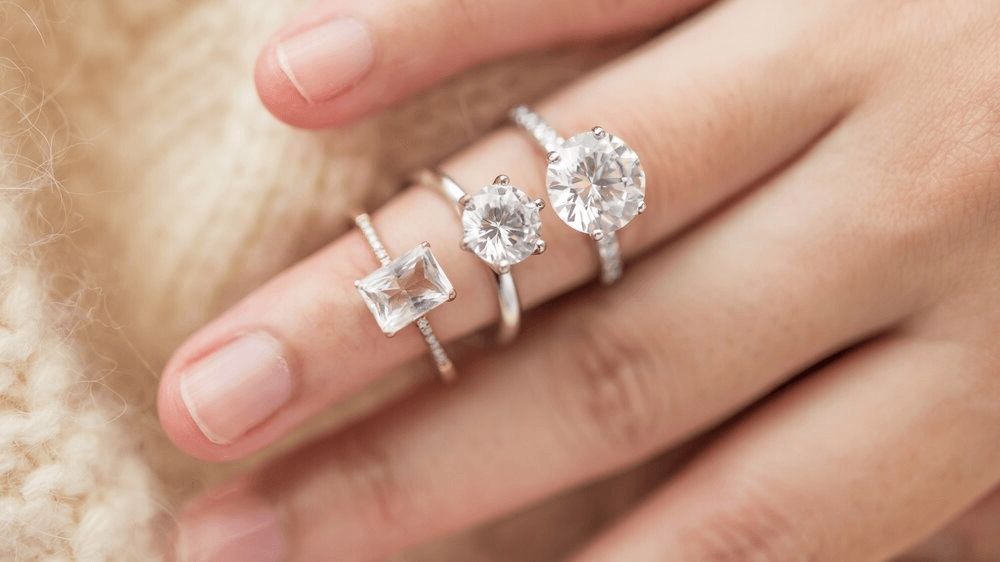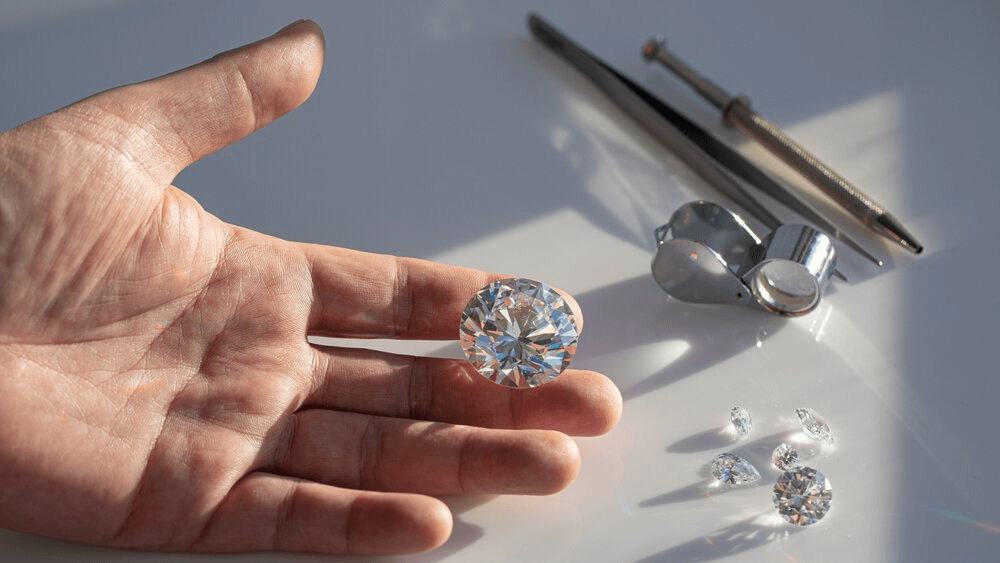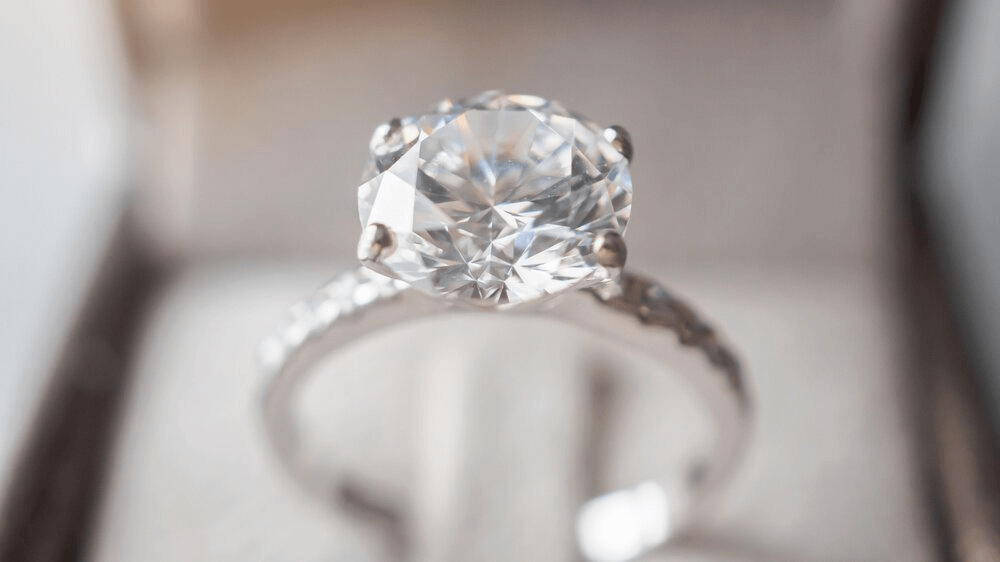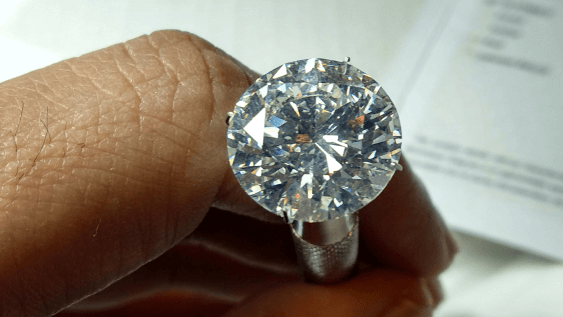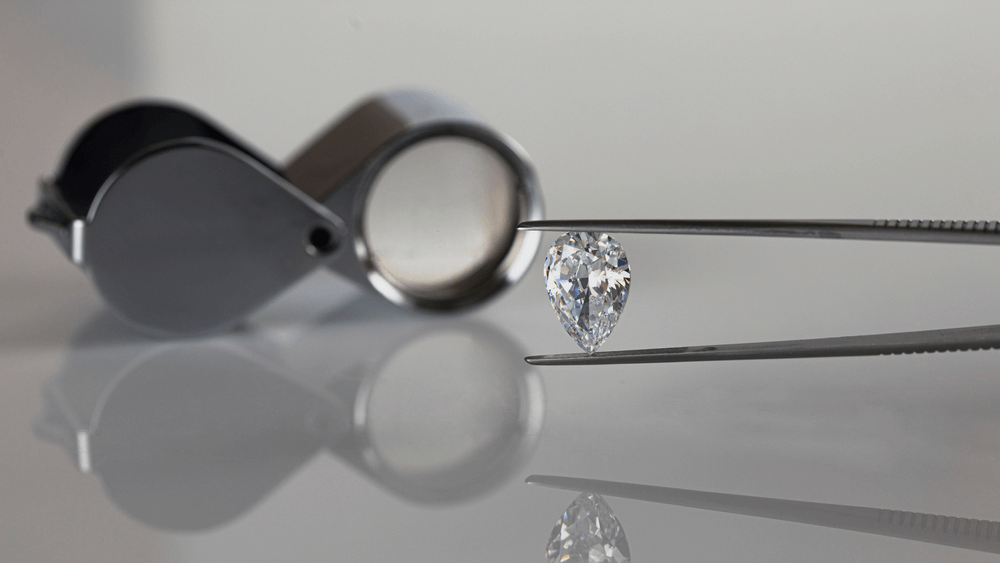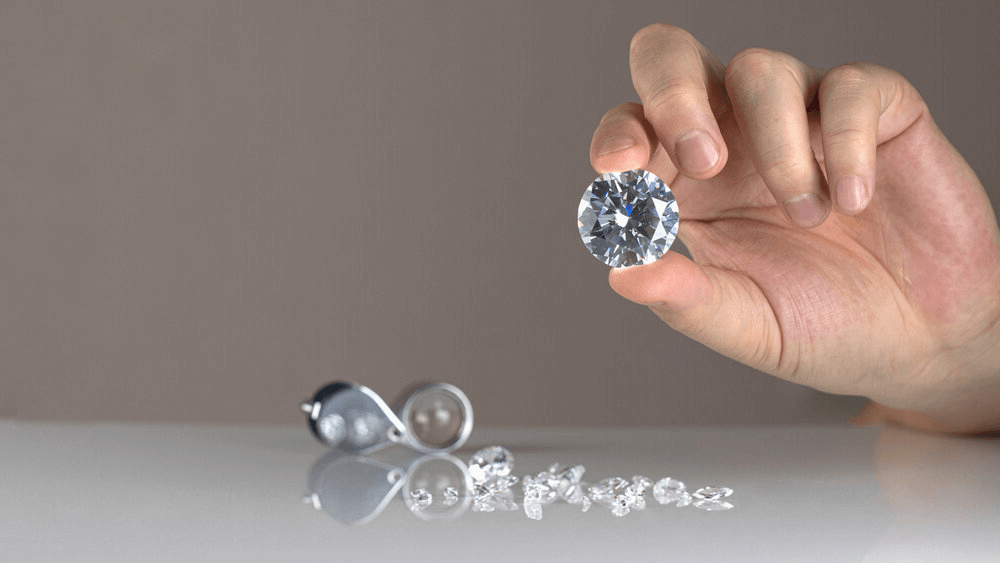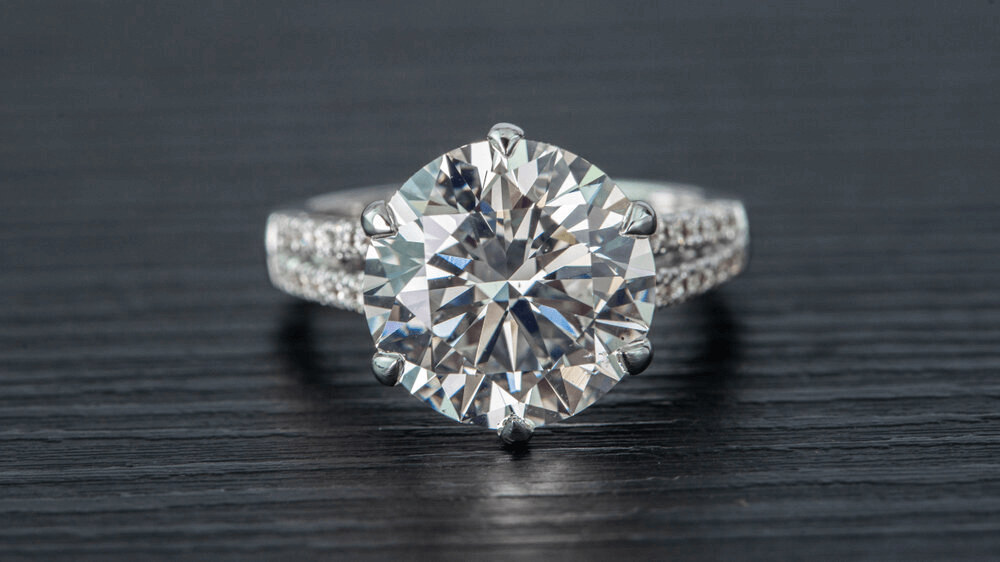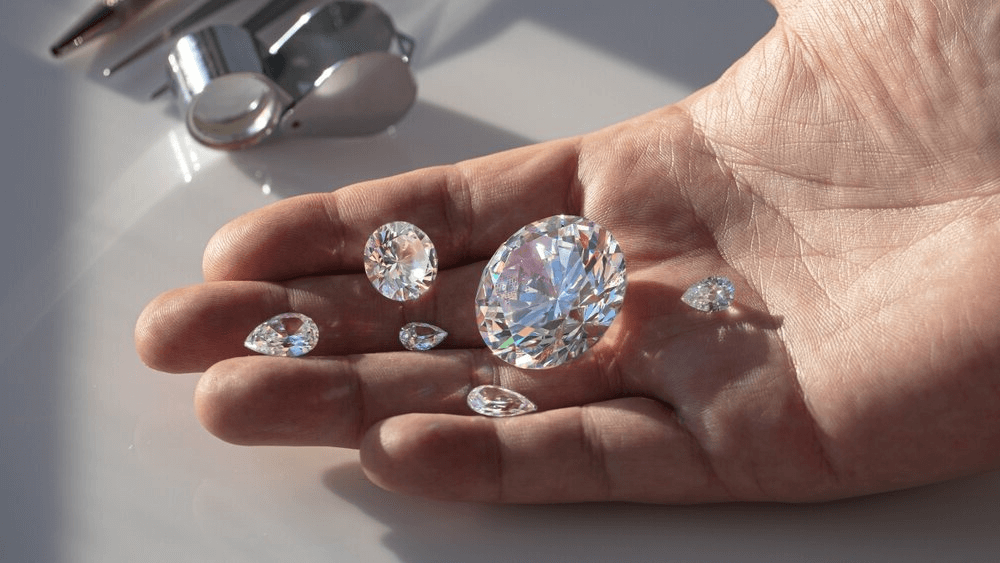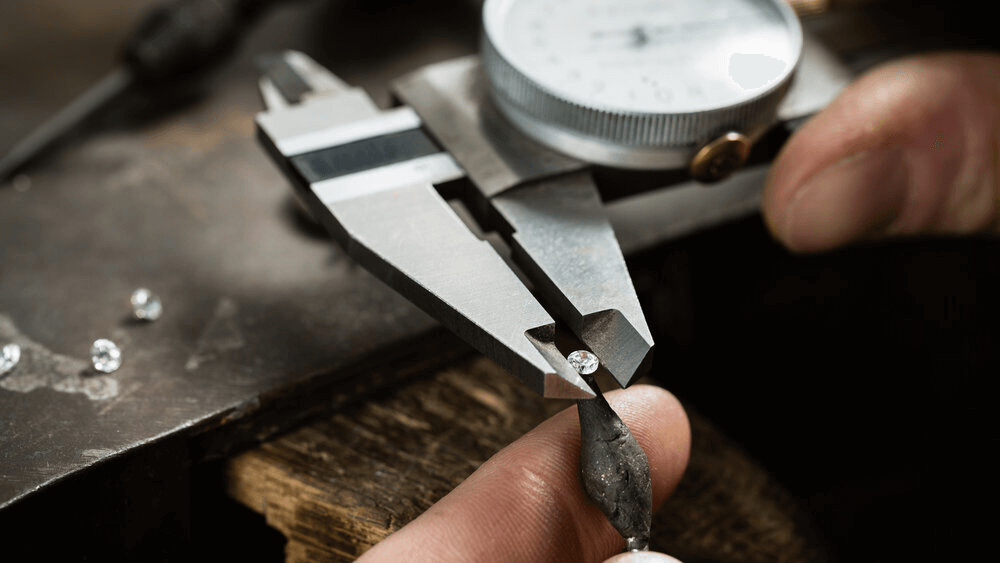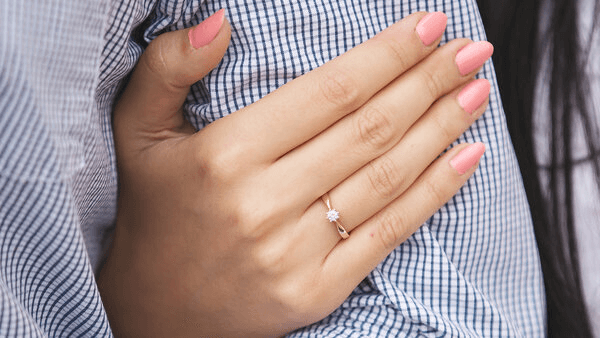6 Carat Diamond Rings: Pricing Breakdown & Value Tips

By Gary A.

Edited by Olivia H.
Published Aug 8, 2024
Edited on Dec 18, 2024
Ready to discover how a 6 carat diamond ring can make your dream proposal dazzlingly unforgettable? Here is everything you need to know about picking (and loving) your 6 carat diamond.

Navigate This Guide:
- 6 Quick Tips for Choosing the Best 6 Carat Diamond for Your Engagement Ring
- Introduction: The Grandeur of 6 Carat Diamonds
- Unveiling the Price Mystique
- Size and Appearance: Perception vs. Reality
- Choosing the Perfect Shape
- The Color and Clarity Conundrum
- The Art of the Cut: Maximizing Brilliance
- Where to Find Your 6 Carat Dream
- Our Expert Take
- 10 Frequently Asked Questions
Before we dive deeper into the specifics, here are some practical tips to help guide your decision-making process:
6 Quick Tips for Choosing the Best 6 Carat Diamond for Your Engagement Ring
- Tip 1: The 4 Cs:
- Cut: This determines how well the diamond reflects light and sparkles. For a 6 Carat Diamond, prioritize an ‘excellent’ or ‘ideal’ cut to ensure maximum brilliance.
- Color: Larger diamonds like 6 Carats can show color more easily. Aim for a higher color grade (G or better) to ensure minimal yellow or brown tint.
- Clarity: While minor inclusions might not be visible in smaller diamonds, they can be more noticeable in larger stones. Consider VS2 or better clarity for a clean appearance.
- Carat: Remember, carat measures weight, not size. Two diamonds with the same carat weight can appear different in size based on their cut.
- Tip 2: Certification:
- Always ensure the diamond comes with a certification from a reputable lab like the GIA (Gemological Institute of America) or AGS (American Gem Society). This certification will verify the diamond’s quality and characteristics.
- Tip 3: Price Comparison:
- Prices for 6 Carat Diamonds can vary significantly based on the 4 Cs and other factors. Do thorough research and compare prices from different retailers. Remember, if a deal seems too good to be true, it probably is.
- Tip 4: Setting and Style:
- The setting can influence how the diamond looks on the finger. For a 6 Carat Diamond, consider a sturdy setting like a four-prong or bezel to securely hold the stone. The style should complement both the diamond and the wearer’s preference.
- Tip 5: Diamond Shape:
- The shape of the diamond can affect its price and appearance. Round diamonds are generally more expensive, while shapes like oval or cushion might offer a larger appearance for the same carat weight.
- Tip 6: Transparency and Fluorescence:
- Check the diamond for any fluorescence, which can make it appear hazy or oily under certain lighting conditions. While some fluorescence can be beneficial in lower color grades, it’s generally best to avoid strong fluorescence in higher color grades.
Now that you’ve got these practical tips, use Jeweler AI below to find the perfect engagement ring that suits your style and budget:
Introduction: The Grandeur of 6 Carat Diamonds
Who was it that said bigger is better? Well, they were right – as it turns out. More specifically, they were right if they were talking about diamonds, particularly if the diamond in question is fated to sit at the center of an engagement ring to knock all other engagement rings out of the water.
We love a showstopper. And, while diamonds (and the rings themselves) are beautiful enough to look incredible at any size or weight, our love for all things fiery, brilliant, and bright means that we’re predisposed to flash the heart-eyes at a 6 carat whopper.
Here’s what you need to know about picking the ultimate in ‘I love yous’: the 6 carat diamond engagement ring.
Unveiling the Price Mystique
If you like to start with the numbers, then you’re in the right place. Anyone investing in a 6 carat diamond want to know first and foremost exactly how much is going to set them back, since, as we all know, big diamonds don’t come cheap.
Factors Influencing the Value
When it comes to any diamond’s value, there are a lot of factors at play. The most significant is, of course, the weight of the diamond. Bigger diamonds are considered to hold such high social status that diamond value increases exponentially with carat weight. This means that it’s a lot more cost effective to buy two 1 carat diamonds than it is to buy one 2 carat diamond, and that you could probably get three 2 carat diamonds for less than one 10 carat diamond.
But it’s not just about weight. While carrot is the first thing most diamond shoppers think of when they start planning to buy a diamond, there are many benchmarks of diamond quality that influence a diamond’s value by hundreds, if not thousands, of dollars.
The most obvious of these are the Four Cs, and we will look at those, and other aspects of diamond quality, below.
The 6 Carat Diamond Price Range
So, let’s start by putting it into concrete terms. If you were to go out today and buy a six carat diamond, what should you expect to pay?
On average, the value of a six carat diamond will vary from as little as $15,000 all the way up to six figures – if the diamond’s quality is hitting all the right notes.
Why does the price vary so much? Because some diamonds are of such poor quality that they really aren’t fit for use in fine jewelry or any jewelry at all. There are plenty of diamonds out there that aren’t worth your money, so don’t assume you’re getting an excellent deal just because you find a six carat diamond worth less than $20,000. If it seems too good to be true, it is.
Generally speaking, shoppers will want to focus on the lower to mid-range of the price bracket. Investing in a diamond at the high end of the pricing range is not a good use of your money, since you can find a diamond that appears to be top quality, but, in actual fact, is worth far less.
Size and Appearance: Perception vs. Reality
That’s enough of numbers. What does a six carat diamond get you in real, concrete terms?
For starters, it gets you a showstopper of an engagement ring. With the national average for carat size sitting around the one carat mark, a 6 carat diamond is ready to blow those other rings straight out of the water.
Understanding Carat vs. Size
as you may have gathered by now, carat is a measurement of weight, not size. Jewellers and gemmologists discussed diamonds in terms of their weight, so you’ll want to get familiar with what a carrot, two carrots, 6 carats really means in terms of size.
It’s important to remember that diamond size (or, at least, the appearance of size) varies even in the same weight range. Since we tend to view diamonds from the top, otherwise known as their face-up appearance, the more weight concentrated into that upper portion, the bigger the diamond looks. When the proportions are off, a diamond can look bigger or smaller (from that face-up appearance) than it should.
Spreading diamonds are the perfect example of this. A spreading diamond is one where too much weight is concentrated into the crown and table, creating a stone that is far too wide and shallow. From above, this diamond looks a lot bigger than its counterparts. From the side, however, you can tell where that weight is missing.
But, how big is a six carat diamond? Or, specifically, how big is it supposed to be?
In a round brilliant diamond cut to ideal proportions, 6 carats equate to approximately 11.6 millimetres in diameter. By contrast, an emerald cut diamond of 6 carats will measure approximately 12mm by 10mm (L:W).
The Visual Impact on the Hand
As you can imagine, this really stands out on the finger. Even a 1 carat diamond is a great size for complimenting the wearer’s hand; not too small, it feels in proportion with most standard ring sizes.
There’s no denying the fact that six carats is big. If you’re used to looking at one carat diamonds, then you’ll need to set tremendous difference when you first try on a six carat diamond. For some people, this might be too big; for anyone who loves a little extra size, it’ll be perfect.
Choosing the Perfect Shape
We hinted at this above, but it deserves closer attention. Different diamond shapes hold their weight differently, which means some diamond shapes will appear bigger than others. When you’re shopping from the six carat range, you really don’t need to worry too much about the shape of your diamond disguising its true size, since you can’t make a six carat diamond look small.
Even so, it’s understandable if you want to make your diamond look as big as possible. Below, we look at some of the shapes that appear the largest on the finger.
Popular Shapes for 6 Carat Diamonds
if size is the name of your game, then some of the best shapes to choose come from the elongated modified brilliance. The oval, marquise, and pear are all great at appearing larger then cuts with square proportions, since more of the diamonds weight needs to be concentrated into the upper portion. That elongated, lengthened silhouette gives the appearance of more weight.
Then again, the jewelry world’s darling, the round brilliant, didn’t rise to the very height of popularity by looking small. While this round cut has even proportions on all sides, it still gets you a lot of bang field buck – or, more aptly, size for your weight.
But don’t neglect their step cuts. The emerald cut is an absolute classic, and very versatile. What it lacks in brilliance and fire, it more than makes up for an elegant shine and luxury. A6 carat emerald cut diamond with an eye clean appearance will really wow onlookers, since those clear, endless depths will draw the eye in from across the room.
The Color and Clarity Conundrum
We said we would review the four seas, and here it is. Clarity and color are two of the best categories for being a little clever, and getting a lot more for a lot less of your money.
Decoding Color Grades
color refers to the presence (or absence) of yellow discoloration, which is itself caused by unwanted traces of nitrogen trapped within the diamond structure. The GIA grades color on a scale that runs from D through Z. While D is technically the best grade, it’s a poor choice for shoppers who want to get the most out of their investment. Grades G through J, otherwise known as the near colorless grades, are far better for shoppers. It’s a great way to save hundreds, if not more, on your ring.
You can read everything you need to know about diamond color here.
Clarity: Seeking Perfection
Clarity refers to the presence (or absence) of inclusions – small floors trapped within the diamond structure that can appear as clouds or spots beneath the surface. Clarity is graded on a scale that runs from flawless through included, and, as with color, the best place for shoppers to focus on is not the upper end of the scale – yes, despite the fact that this is technically the best of the best.
You can read everything you need to know about clarity here.
The Art of the Cut: Maximizing Brilliance
Cut is arguably the most important of the Four Cs. A diamond with a poor cut won’t sparkle like it should — and, no, you won’t get used to it. There are five grades on the GIA’s cut scale, but we only ever recommend the top two: excellent and very good. This is not the place to save your money.
You can read all about diamond cut here.
Setting the Stage: Ring Settings for 6 Carat Diamonds
So, you found your diamond – or, in the very least, you know exactly what to look for. What now? Next, you need to pick the engagement ring – the housing, in other words, for your 5-figure diamond.
But how do you do that stone justice?
Solitaire Elegance
A diamond solitaire is ready to wow whether it holds a 0.5 carat diamond or a 10 carat diamond, but a six carat crowd pleaser really is a great way to make this timeless engagement ring style sing.
The pared back, unobtrusive nature of this ring style means that the full size of your diamond is there to see. You don’t need to worry about any of the ring’s features swallowing up carat weight, and making your diamond appear smaller than it really is.
Remember that the beauty of the solitaire lies in simplicity. This really is your opportunity to let the diamond do the talking, and we can assure you that a six carat diamond has a lot to say.
The Halo Effect
6 carats is a lot, but there’s always room for more. If you really want your engagement ring to carry weight and authority on the wearer’s hand, then a halo is a great way to add extra power to the ring’s design, without forcing you to shell out on a diamond twice the size.
A halo is a real classic engagement ring design. You can stick with a simple, single halo – in other words, one row of melee diamonds around the circumference of your stone. Or, if you know your partner is all about bling, consider adding a double or triple row of diamonds. Melee diamonds are significantly cheaper than larger diamonds, so you don’t have to worry about the cost of your engagement ring snowballing.
Where to Find Your 6 Carat Dream
Call us biased, but the very best place to find your engagement ring is willyou.com. We’re not just about pairing up engagement rings with soon-to-be fiancées, we are about ensuring that the entire process of choosing an engagement ring, from start to finish, is tailored to you and your partner’s unique love story.
It’s not just about finding a diamond and setting, but about finding the diamond and the settings that you were always supposed to choose, from tailoring everything to your budget to ensuring every single one of your expectations are met.
We have guides for every aspect of the engagement ring buying process, and, for everything else, you have our Jeweler AI to help all the pieces fall together.
You also have the security of our stringent diamond selection process. We don’t just sell any and every diamond we get our hands on. We select everything based on our own high standards and don’t recommend diamonds to shoppers that we wouldn’t personally be happy with buying ourselves.
Our Expert Take
Being in the market for a six carat engagement ring is a great place to find yourself. While it can feel very daunting, particularly with the massive difference in prices between one 6 carat diamond in the next, there is always a way to make it make sense. With the right guidance, you know they’ll walk out of the process with an engagement ring that turns heads and leaves onlookers in no doubt about your relationship status from here on out.
10 Frequently Asked Questions
- Q: What makes a 6 Carat diamond ring so special?
- A: A 6 Carat diamond ring stands out due to its significant size, rarity, and the luxurious statement it makes. Its large surface area allows for exceptional brilliance and sparkle.
- Q: How much does a 6 Carat diamond ring typically cost?
- A: The price of a 6 Carat diamond ring can vary widely from $61,710 to $955,152 or more, depending on factors like cut, color, clarity, and the chosen setting.
- Q: Can the shape of a 6 Carat diamond affect its appearance on the finger?
- A: Yes, the shape of a 6 Carat diamond can significantly influence its appearance. Elongated shapes like Oval, Pear, or Marquise can elongate the finger, while round or cushion shapes offer a classic, balanced look.
- Q: What color grade should I choose for a 6 Carat diamond?
- A: For a 6 Carat diamond, a color grade of G or higher is recommended to ensure the diamond appears white and vibrant in its setting, especially if set in white gold or platinum.
- Q: Is clarity more important in larger diamonds like a 6 Carat?
- A: Yes, clarity becomes increasingly important in larger diamonds because inclusions and blemishes are more visible. A clarity grade of VS2 or higher is often recommended for 6 Carat diamonds.
- Q: Does the cut of a 6 Carat diamond affect its price?
- A: Absolutely, the cut quality of a 6 Carat diamond greatly affects both its brilliance and price. An excellent or ideal cut can maximize the diamond’s sparkle and make it appear even larger.
- Q: How do I ensure I’m getting a good deal on a 6 Carat diamond ring?
- A: To ensure a good deal, compare prices from reputable dealers, verify the diamond’s GIA or AGS certification, and consider the diamond’s 4 Cs to balance quality with your budget.
- Q: Are there any specific settings recommended for a 6 Carat diamond ring?
- A: Sturdy settings like prong, bezel, or halo are recommended for 6 Carat diamonds to securely hold the diamond and enhance its presence without overpowering the design.
- Q: What is the impact of fluorescence on a 6 Carat diamond?
- A: Fluorescence can affect the appearance of a 6 Carat diamond under certain lighting conditions, potentially making it look hazy. It’s generally best to choose a diamond with faint or no fluorescence.
- Q: How can I customize a 6 Carat diamond ring to make it unique?
- A: Customizing a 6 Carat diamond ring can involve selecting a unique setting, incorporating side stones, choosing an unusual diamond shape, or adding personal design elements to the band.
Find your perfect 6 Carat Diamond Ring with Jeweler AI—where your dream ring becomes reality.
Here are more specific diamond prices topics to browse:
- Melee Diamonds: The Perfect Accents to Enhance the Center Stone
- Small Diamond Engagement Rings: Big Sparkle Comes In Little Packages
- 0.25 Carat Diamond: Tiny Treasure or Just Too Small?
- The True Value of a 0.5 Carat Diamond Ring Revealed
- 0.7, 0.8, 0.9 Carat Diamond Showdown: Which One Wins?
- Price Alert: Don’t Overpay for a 1 Carat Diamond Ring!
- What You Should Pay for a 1.5 Carat Diamond Ring?
- Price Alert: How Much Should You Pay for a 2 Carat Diamond Ring?
- How Much Does a 2.5 Carat Diamond Really Cost?
- The Real Cost of a 3 Carat Diamond Ring
- Industry Secret: How Much Does a 4-Carat Diamond Ring Actually Cost?
- How Much is Too Much? The True Cost of 5 Carat Diamond Ring!
- 7 Carat Diamond Rings: Affordable Luxury Prices Revealed
- 8 Carat Diamond Rings: Price Comparison & Savings Tips
- 9 Carat Diamond Rings: Detailed Pricing Guide & Best Deals
- 10-13 Carat Diamonds: The Ultimate Symbol of Luxury!
- 15 Carat Diamonds: Why Celebrities Love Them!
- Unveiling the Majesty: The Secrets Behind the 20 Carat Diamond Ring!
- Decoding the Grandeur: The Journey to Choosing a 25 Carat Diamond Ring
- Average Carat Size for Rings: What’s the Ideal?
- Understanding What Is CTTW Diamond In Engagement Ring
- The Truth About Why Diamonds Are So Expensive and Incredibly Valuable
FOLLOW-UP GUIDE SERIES

